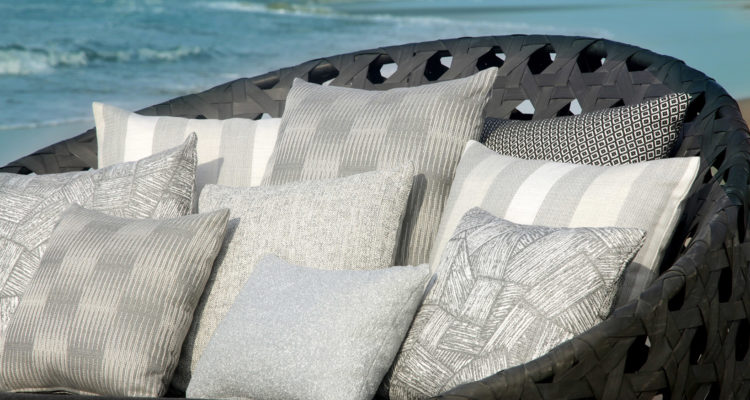Unfazed by Nature and Oh-So Durable
Story by Ann Butenas | Intro photo courtesy of Kravet
All-weather textiles are making waves these days. While durable and built to withstand the elements, they also have a softer and stylish draw to them. No matter the space – an expansive open air living area or simply a comfy day bed on the back porch or a cozy al fresco seating area – the appeal lies not just within the benefits of the fresh air, but also in the grand selection of outdoor fabrics that tempt not only in style, colors and durability, but also in their soft and cozy feel.
Plus, with all of the advancements and improvements in all-weather fabrics, these fabrics can withstand the elements with style while still remaining porous enough to allow for flexibility.
Kristy Nguyen, Managing Partner at Design and Detail – Kansas City, offered a few insights as to what to look for in outdoor fabrics, from hard-working linens to velvets (yes, velvets!) She advised us on everything from selection to maintenance. So, before you pick out your favorite fabric, it’s a good ideato know what you are looking for in the first place.With so many styles and selections available, the possibilities may seem endless.
Photo courtesy of Osborne & Little
KCH&S: What should I look for when buying outdoor fabrics?
NGUYEN: There are so many styles available now, with more coming to the market regularly. What you want to look for most of all is a performance fabric, which allows for longevity. Look for a solution-dyed acrylic, which has a yarn that is dyed all the way through, making it fade resistant.
KCH&S: How do I know how durable a fabric is?
NGUYEN: You want to look for durability and fade resistance ratings. When companies test their fabrics, they use a light fastness test to determine how long a fabric might last in the sun. A lower, inexpensive fabric may have a rating of 1000 hours. A higher quality one might have a rating of 5,000-6,000 hours. A good fabric will offer about five to six years of guaranteed fade resistance. However, three years is normal. At that time, you may just want to switch out the fabric. Fabrics can last longer if you take care of them. Here in the Midwest, we tend to bring our outdoor furniture in during the colder months, which adds to their longevity.
Photo courtesy of Kravet
KCH&S: Aside from covering your outdoor furniture, how else should you care for your outdoor fabrics?
NGUYEN: One of the great things about outdoor fabrics is that they are anti-mold and mildew resistant. They are also bleachable. You can simply spray them with a garden hose for easy cleaning. For a deeper cleaning you can use a small amount of laundry detergent but make sure you clean it out well, as any remaining soap will collect dirt. You can also clean them with a bleach and water solution for any stubborn stains. Just be sure to thoroughly rinse the fabrics afterwards and give them time to dry before you sit on them. And it’s always a good idea to rinse and/or brush them off at the end of summer before storing them. It all really depends on how much you use them.
Photo courtesy of Osborne & Little
KCH&S: What are some of the latest outdoor fabric styles?
NGUYEN: Monochromatic is a trend now and is used year-round on covered porches. We are also seeing more textures in outdoor textiles, including wool-like fabrics, terry cloth and even outdoor velvet, offering a more luxurious yet casual feel. There has also been a huge uptick in subtle colors, such as transitioning from bright green to sage green or hot pink to blushes, making the fabrics more elegant. For bed swings and fire pit areas, plaid and wool-like throws are popular. They are outdoor-friendly but make you feel like you are inside. White is also now used more frequently because it is cleanable with bleach. Some people even use this type of fabric for inside furniture, as it’s easy to clean up after kids and pets. Fade-resistant outdoor vinyl works well for boats and bar stools.









